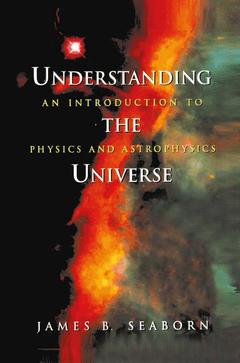Understanding the Universe, 1998 An Introduction to Physics and Astrophysics
Langue : Anglais
Auteur : Seaborn James B.

For the last eighteen years, I have been teaching an introductory course in as trophysics. The course is intended for nonscience majors satisfying a general education requirement in natural science. It is a physics course with applications in astronomy. The only prerequisite is the high school mathematics required for ad mission to the university. For a number of years, I used an astronomy text, which I supplemented with lecture notes on physics. There are many good astronomy texts available, but this was not a satisfactory state of affairs, since the course is a physics course. The students needed a physics text that focused on astronomical applications. Over the last few years, I have developed a text which my students have been using in manuscript form in this course. This book is an outgrowth of that effort. The purpose of the book is to develop the physics that describes the behavior of matter here on the earth and use it to try to understand the things that are seen in the heavens. Following a brief discussion of the history of astronomy from the Greeks through the Copernican Revolution, we begin to develop the physics needed to understand three important problems at a level accessible to undergraduate nonscience majors: (1) the solar system, (2) the structure and evolution of stars, and (3) the early universe. All ofthese are related to the fundamental problem of how matter and energy behave in space and time.
1. Watchers of the Heavens.- 1.1. Celestial Motions.- 1.2. Early Astronomy.- 1.3. The Copernican Revolution.- Exercises.- 2. The Stuff Moves Around.- 2.1. Fundamental Properties.- 2.2. Derived Quantities.- 2.3. Scalars and Vectors 21 Exercises.- 3. Eyes on the Skies.- 3.1. Wave Phenomena.- 3.2. Reflection and Refraction of Light.- 3.3. The Doppler Effect.- Exercises.- 4. Newton Puts It All Together.- 4.1. Newton’s Laws of Motion.- 4.2. Linear Momentum.- 4.3. Weight.- Exercises.- 5. Running the Machine.- 5.1. Mechanical Work.- 5.2. Energy.- 5.3. Collisions.- 5.4. Power.- Exercises.- 6. Off the Straight and Narrow.- 6.1. Uniform Circular Motion.- 6.2. Centripetal Force.- Exercises.- 7. The Gravity of It All.- 7.1. Early Speculations.- 7.2. Newton’s Law of Universal Gravitation.- 7.3. Measurement of the Force Constant.- 7.4. Escape Velocity.- 7.5. Planetary Atmospheres.- Exercises.- 8. Round and Round She Goes.- 8.1. Orbital Motion.- 8.2. Artificial Satellites in Earth Orbit.- Exercises.-9. As the World Turns.- 9.1. Mechanical Equilibrium.- 9.2. The Origin of the Solar System.- Exercises.- 10. Let There Be Light!.- 10.1. Electricity.- 10.2. Magnetism.- 10.3. Induced Electric Currents.- 10.4. Electromagnetic Radiation and Light.- 10.5. The Earth’s Magnetic Field.- 10.6. Electric Potential Energy.- Exercises.- 11. What’s the Matter?.- 11.1. Thomson’s Model of the Atom.- 11.2. The Discovery of Radioactivity.- 11.3. The Geiger—Marsden Experiment.- 11.4. Rutherford’s Model of the Atom.- Exercises.- 12. Hot Stuff.- 12.1. Radiation from Hot Matter.- 12.2. The Failure of Classical Physics.- 12.3. Planck’s Quantum Hypothesis.- Exercises.- 13. Einstein’s Bundles.- 13.1. The Photoelectric Effect.- 13.2. Momentum of Light.- 13.3. Equivalence of Mass and Energy.- Exercises.- 14. The Great Dane.- 14.1. The Structure of the Atom.- 14.2. The Man from Copenhagen.- 14.3. Comets.- Exercises.- 15. Sugar and Spice and Everything Nice.- 15.1. The Many-Electron Atom.- 15.2. Atomic Spectra.-15.3. The Periodic Table of the Elements.- Exercises.- 16. The Starry Messenger.- 16.1. Intrinsic Brightness.- 16.2. Stellar Spectra.- 16.3. The Hertzsprung—Russell Diagram.- 16.4. Binary Stars.- Exercises.- 17. The Sun Is a Gas.- 17.1. Boyle’s Law.- 17.2. A Molecular Model of the Gas.- 17.3. The Ideal Gas Law.- 17.4. Absolute Temperature.- Exercises.- 18. The Sun Is a Nuclear Furnace.- 18.1. The Structure of the Atomic Nucleus.- 18.2. Nuclear Reactions.- Exercises.- 19. No More to Wonder What You Are.- 19.1. The Evolution of a Star Like the Sun.- 19.2. The Evolution of a Heavier Star.- 19.3. The Stuff Between the Stars.- 19.4. Solar Neutrinos.- Exercises.- 20. The Flight of the Galaxies.- 20.1. The Nebulae.- 20.2. Variable Stars and Cosmic Distances.- 20.3. Hubble’s Discovery.- 20.4. The Structure of a Spiral Galaxy.- Exercises.- 21. The Big Picture.- 21.1. The Cosmological Principle.- 21.2. The Quasars.- 21.3. The Cosmic Background Radiation.- 21.4. A Final Word.- Exercises.- Appendix A. Linear Graphs.- Exercises.- Appendix B. Physical and Astronomical Data.- Appendix C. Useful Formulas.- Appendix D. The Chemical Elements.- Appendix E. The Brightest Stars in the Sky.
Date de parution : 10-2012
Ouvrage de 304 p.
15.5x23.5 cm
Thème d’Understanding the Universe :
Mots-clés :
Atom; Cosmology; Universe; astrophysics; electricity; magnetism; mechanics
© 2024 LAVOISIER S.A.S.
